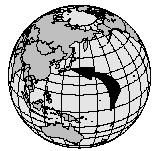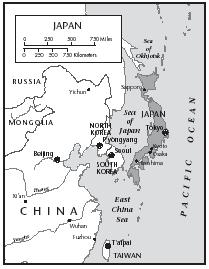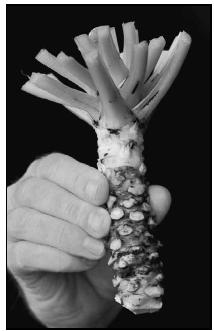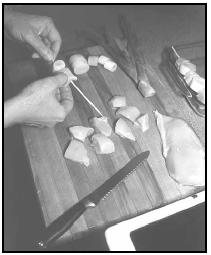Japan
Recipes

1 GEOGRAPHIC SETTING AND ENVIRONMENT
Japan is an archipelago (chain of islands) made up of about 3,000 islands. About twothirds of the land is too mountainous for development, so almost all the people live in cities, most of which were built on the country's flat land (plains area). The country sometimes experiences natural disasters, such as typhoons (huge storms originating over the ocean) and earthquakes.
Some mountainous areas have been terraced (had step-like areas cut into them) to allow farmers to grow rice and other crops. The climate is good for farming, with rice being the chief crop. About half of Japan's arable land (land able to be farmed) is devoted to growing rice. From the 1970s to the 1990s, the production of Japan's livestock farmers doubled.
Japan accounts for about 8 percent of all the fish caught in the world. Japanese people consume large amounts of fish. Each person in Japan eats more than 150 pounds of fish per year, or around three pounds of fish per week.
2 HISTORY AND FOOD
Japanese cuisine has been influenced by the food customs of other nations, but has adopted and refined them to create its own unique cooking style and eating habits.
The first foreign influence on Japan was China around 300 B.C. , when the Japanese learned to cultivate rice. The use of chopsticks and the consumption of soy sauce and soybean curd (tofu) also came from China.
The Buddhist religion, one of the two major religions in Japan today (the other is

Beginning in the early 1200s, trade with other countries began bringing Western-style influences to Japan. The Dutch introduced corn, potatoes, and sweet potatoes. The Portuguese introduced tempura (batter frying).
After a ban of more than one thousand years, beef returned to Japan during the Meiji Period (1868–1912). Western foods, such as bread, coffee, and ice cream, become popular during the late twentieth century. Another Western influence has been the introduction of timesaving cooking methods. These include the electric rice cooker, packaged foods such as instant noodles, instant miso (fermented soybean paste) soup, and instant pickling mixes. However, the Japanese are still devoted to their classic cooking traditions.
3 FOODS OF THE JAPANESE
Rice and noodles are the two primary staples of the Japanese diet. Rice, either boiled or steamed, is served at every meal. Noodles come in many varieties. Among the most popular are soba, thin brown noodles made from buckwheat flour; udon, thick white noodles made from wheat flour; and ramen, thin, curly noodles, also made from wheat flour . Soy sauce and other soybean products are also staples in Japan. These include miso (fermented soybean paste) and tofu (a soybean curd that resembles custard). Other common ingredients in Japanese food include bamboo shoots, daikon (a giant white radish), ginger, seaweed, and sesame seed products. Japanese pickles called tsukemono are served at every meal. Seafood is also plentiful in this island nation. Green tea is the national beverage of Japan, although black tea is also available. Sake (SAH-kee, wine made from rice, usually served warm) and beer are also very popular.
Two uniquely Japanese foods are sushi (fresh raw seafood with rice) and sashimi (fresh raw seafood with soy sauce); both rely on freshly caught fish or seafood. Dishes prepared in a single pot ( nabemeno ) are popular throughout Japan. Sukiyaki is a dish made up of paper-thin slices of beef (or sometimes chicken), vegetables, and cubes of tofu cooked in broth. Shabu-shabu is beef and vegetables, also cooked in broth but then dipped in flavorful sauces. Each region has its own selection of favorite foods. People living on the cold northern island of Hokkaido enjoy potatoes, corn, and barbecued meats. Foods in western Japan tend to be more delicately flavored than those in the east.
The Japanese are known for using very fresh ingredients in their cooking. They prefer using fresh, seasonal foods for their meals, buying it the same day it will be cooked. The Japanese are also famous for their skill in arranging food so that it looks beautiful. The people of Japan live long lives and have a low rate of heart disease because of healthy eating habits.
Gohan (Boiled Rice)
Ingredients
- 1 cup Japanese short-grain rice, uncooked (available at most supermarkets and Asian food stores)
- 1¼ cups water
Procedure
- Wash the rice and allow it to soak in a saucepan for about 30 minutes; let drain.
- Return the rice to the saucepan, add water, and bring to a boil over high heat.
- Reduce heat, cover, and let simmer, cooking about 15 minutes more until water has been absorbed by the rice.
- Reduce the heat to medium and keep covered, allowing rice to steam for about 15 minutes.
- Serve in individual bowls with chopsticks (optional).
Serves 4. To eat rice, the rice bowl is held in the left hand, close to the mouth. The chopsticks are used to push the rice into the mouth as the bowl is slowly rotated in the hand.
Sushi
Ingredients
- Small bamboo mat (makisu) for preparing sushi
- Dry seaweed sheets (nori)
- Bowl of water to which 1 Tablespoon vinegar has been added
- Wasabi (dried horseradish powder)
- Strips of avocado, cucumber, carrot, or other vegetable
- Cooked shrimp or crab meat (or frozen imitation crabmeat, thawed)
Procedure
- Place a sheet of nori (dry seaweed), shiny side down, on the makisu (bamboo mat).
- Wet your right hand (or left hand, if you are left-handed) in the bowl of vinegar water, and use it to scoop up a ball of rice.
- Spread the rice out in an even layer on one side of the nori .
- Sprinkle a line of wasabi (horseradish powder) down the center of the rice.
- Arrange the strips of vegetables and seafood over the line of wasabi .
- Using the mat to support the nori , lift one end of the mat to gently roll the nori over the rice and other ingredients.
- Use gentle pressure to compact the rice and other ingredients so that they hold together.
- Continue rolling until a long cylinder is formed, completely encased in nori .
- Carefully slice through the nori and other ingredients to make the bites of sushi .
- Serve immediately so the nori will still be crispy.

Onigiri (Rice Ball)
Ingredients
- 2 cups cooked rice
- Salt
- Pickled plums, cut into small, bite-sized pieces
- Cooked salmon, cut into small, bite-sized pieces
- Dry seaweed sheets (nori), cut into strips
Procedure
- Cook rice according to directions on package. Allow to cool slightly.
- Have a bowl of lukewarm water handy.
- Dip clean hands into water, and then sprinkle salt on wet hands.
- Place a small mound of rice (about 2 Tablespoons) in the palm of your hand.
- Press a piece of pickled plum or cooked salmon into the mound of rice.
- Toss the mound back and forth between wet, salted hands to form a triangular mound, with the filling item in the center.
- Wrap mound in a dry seaweed strip.
Serves 10 to 12.
Miso Soup
Ingredients
- 2 scallions
- ¼ pound tofu
- 1¼ cups dashi (Japanese fish stock) or 1 chicken bouillon cube, dissolved in 1 cup boiling water
- 2 Tablespoons red miso
Procedure
- Wash the scallions and cut the green parts into 1½-inch lengths.
- Cut the tofu into small cubes and place the scallions and tofu in soup bowls.
- Boil the dashi (broth) in a saucepan.
- Put a little of the boiling liquid in a bowl and mix with the miso .
- Pour back into the saucepan, then ladle into the soup bowls.
- Serve immediately.
Makes one serving.
Beef Sukiyaki
Ingredients
- ½ cup soy sauce
- ¼ cup sugar
- ½ cup dashi or beef broth
- 2 Tablespoons vegetable oil
- 1 pound beef tenderloin, sliced into thin strips
- 10 scallions, cut into 2-inch pieces (both and green and white parts)
- 4 stalks celery, sliced on an angle, in ½-inch pieces
- 12 mushroom caps, sliced
- 8 ounces tofu or bean curd, cut into bite-sized cubes
- 1 can bamboo shoots (8½-ounce), drained
- 4 cups rice, cooked
Procedure
- Mix soy sauce, sugar, and dashi or broth in a bowl and set aside.
- Arrange beef and vegetables on a large platter.
- Heat an electric skillet 300°F; or heat a frying pan over medium-high heat. Add oil and heat.
- Add the meat and brown for 2 minutes.
- Add the vegetables and the tofu, including the bamboo shoots, placing each on its own part of the skillet.
- Add the sauce and cook mixture for 6 to 7 minutes, turning gently to prevent burning and keeping all ingredients separate from each other. Serve at once over rice.
Serves 4 to 6.
Chicken Teriyaki
Ingredients
- ½ cup soy sauce (preferably Japanese-style)
- 3 Tablespoons sugar
- 1 teaspoon fresh gingerroot, grated
- 3 Tablespoons sesame seeds
- 1½ to 2 pounds skinless, boneless chicken breast, cut into small serving pieces
Procedure
- Preheat oven to 375°F.
- Combine soy sauce, sugar, gingerroot, and sesame seeds in a large bowl.
- Place chicken in a baking dish and pour sauce over it.
- Bake for 45 minutes. Turn chicken about every 15 minutes, coating with sauce in the process.
Serves 6.
Doll Festival Menu
Pork and cabbage dumplings
Sushi
Peach tofu
Vegetables with vinegar lemon dressing
Sake
Harvest Moon Menu
Miso soup
Tempura
Rice
Deep-fried oysters
Daikon salad
Red bean jelly
New Year's Menu
Miso soup with grilled rice cakes
Sashimi shaped into roses
Sushi canapés
Beef and onion rolls
Smoked salmon and daikon rolls
Persimmon and daikon salad
Spicy braised gobo (burdock root)
Yaki-Soba (Fried Noodles)
Ingredients
- 2 to 3 medium-size shiitake mushrooms
- 8 ounces fresh ramen or 6 ounces dried noodles
- 3 Tablespoons vegetable oil
- 1 small to medium-size onion, chopped
- 2 teaspoons gingerroot, minced
- 2 cups green cabbage leaves, coarsely chopped
- 1 Tablespoon mirin (sweet rice wine)
- 2 to 3 teaspoons soy sauce
- 2 to 3 dashes black pepper
- Salt, to taste
Procedure
- Soak mushrooms in a bowl of warm water for 30 minutes.
- Dry mushrooms. Cut off stems and discard. Slice mushrooms thinly.
- Bring 3 quarts of water to a boil in a large pot and add ramen . Cook 1 to 2 minutes or until tender yet firm.
- Rinse ramen ; drain well. Toss with 1 Tablespoon of the oil; set aside.
- Heat remaining 2 Tablespoons oil in a wok or large skillet over medium to high heat.
- Add onion and gingerroot and stir-fry for 2 minutes.
- Add cabbage and mushrooms; stir-fry 3 minutes. Sprinkle with mirin . Stir-fry 1 minute more.
- Add ramen ; toss until hot. Season with soy sauce, pepper, onions, and salt.
- Shrimp, ham, chicken, or other tempura can be added.
Serves 6.
4 FOOD FOR RELIGIOUS AND HOLIDAY CELEBRATIONS
The most important holiday in Japan is the New Year, Shogatsu. Special holiday foods, called osechi , are prepared in beautifully decorated stackable boxes called jubako. Each layer of the box has compartments for several different foods. Glazed sardines, bamboo shoots, sweet black beans, and chestnuts in sweet potato paste are just a few of the many holiday foods. New Year foods are also eaten because they are believed to represent good fortune or long life. At New Year's, children are especially fond of hot rice cakes dipped in sweet soybean powder.
The Girls' Festival (or Doll Festival) is held in March. Dolls are dressed in traditional Japanese dresses called kimonos and are offered rice crackers, colored rice cakes, and a sweet rice drink called amazake . Everyone in the family eats the foods. Festive foods for Children's Day (May 5) include rice dumplings stuffed with sweet bean paste.
The tea ceremony ( cha-no-yu ) is an important Japanese ritual that can be held on a holiday or other special occasion. Developed over several centuries, it plays an important role in Japanese life and culture.
Ozoni (New Year's Soup)
Ingredients
- 4 mochi (rice cakes)
- 2 boned chicken breasts, trimmed and sliced into thin strips
- 2 thin leeks, sliced very finely on the diagonal
- 4 cups dashi
- 3 Tablespoons white miso
Procedure
- Broil the mochi cakes under a hot broiler on all sides until the cake is crisp and brown, but not burnt.
- Remove from heat, piece with a fork, and set aside.
- Dip the chicken slices into salted boiling water for 2 minutes, then drain.
- Bring the dashi to a boil in a saucepan, then add chicken pieces and simmer until tender.
- Ladle ½ cup of dashi into the miso and whisk until blended.
- Pour back into the soup and bring just to a boil, then remove from heat.
- Place a cooked rice cake in the bottom of each of 4 bowls, then ladle the soup over them, distributing the chicken pieces evenly. Top with slivered leek.
- Place tops on the bowls, and serve immediately.
Serves 6 to 8.
Sweet Peanut Mochi (Rice Cakes)
Rice cakes are a popular dessert for both New Year's and Children's Day. These may sometimes be purchased at Asian markets or specialty grocery stores.
Ingredients
- 1 cup sweet glutinous-rice flour ( mochiko )
- ¼ teaspoon salt
- ¼ cup light brown sugar, packed
- ⅓ cup cocktail peanuts, unsalted
- ½ cup water
- Potato starch or cornstarch
- Orange blossom honey, rice syrup, or molasses
- ½ cup roasted soybean powder ( kinako ) (optional)
Procedure
- In a medium-size bowl, combine rice flour, salt, and brown sugar.
- In a blender or food processor, grind peanuts until they form a paste.
- Add the water; process until blended, scraping sides of container once or twice.
- Pour peanut mixture into rice-flour mixture. Stir to form a stiff dough.
- Lightly knead dough about 30 seconds.
- In a wok or deep pot, bring 4 cups of water to a boil.
- Spread a piece of dampened and unbleached muslin or several layers of cheesecloth over a steamer tray.
- Spread the dough evenly over the cloth, about ½-inch thick.
- Place the steamer into the pot, over the boiling water. Cover and steam for 20 minutes.
- Remove tray from pan and lift out cloth with dough.
- Pull away cloth, dropping dough onto a flat surface dusted with potato starch or cornstarch. Cool 2 minutes.
- Knead 1 minute or until smooth and shiny.
- Roll dough into an 8-inch long sausage roll and cut into 8 equal pieces.
- Dust lightly with cornstarch to prevent sticking. Form into smooth, round shapes.
- Drizzle rice cakes with honey and roll in soybean powder.
- Serve on small plates with cups of hot green tea.
5 MEALTIME CUSTOMS
The Japanese eat three main meals a day. The main ingredient in all three, however, is rice (or sometimes noodles). Miso soup and pickles are always served as well. Meals eaten early in the day tend to be the simplest. A typical breakfast consists of rice, miso soup, and a side dish, such as an egg or grilled fish.
Noodles are very popular for lunch (and as a snack), and a restaurant or take-out stand referred to as a noodle house is a popular spot for lunch. A typical lunch would be a bowl of broth with vegetables, seaweed, or fish. The bento is a traditional box lunch packed in a small, flat box with dividers. It includes small portions of rice, meat, fish, and vegetables. Stores sell ready-made bento for take out and some even have Western-style ingredients like spaghetti or sausages. A favorite among young people, and as a take-out food, is a stuffed rice ball called onigiri.
Many Japanese have turned to Western-style food for breakfast and lunch, especially in the cities. However, traditional dinners are still eaten by most people in Japan, such as rice, soup, pickles, and fish. Seasonal fresh fruit makes a great dessert. Sweets are more likely to be served with green tea in the afternoon.
Food is grasped between chopsticks and lifted to one's mouth. Chopsticks should never be stuck into a piece of food or used to pass food back and forth. It is not considered impolite to sip one's soup directly from the bowl. At a Japanese meal, people at the table fill each other's drinking glasses but never their own.
The Japanese do not eat while they are doing other things, such as walking or driving. A Japanese car company once claimed that some of its seatbelts didn't work properly in the United States because Americans spilled so much food in their cars. They believe people should not eat and drive cars at the same time.
Yakitori (Grilled Chicken on Skewers)
Ingredients
- 2 skinless, boneless chicken breasts
- 2 small leeks
- 2 teaspoons sugar
- 4 Tablespoons soy sauce
- Bamboo skewers, soaked in water for 30 minutes prior to using
Procedure
- Cut chicken into bite-sized chunks.
- Wash leeks, remove the roots, and cut into ¾-inch lengths.
- Slide the chicken and leeks onto bamboo skewers.
- In a bowl, mix the sugar and soy sauce together.
- Spoon a little of this mixture over the chicken skewers.
- Broil for 5 minutes.
- Turn the skewers over, spoon on some more sauce, and cook for 5 more minutes.
- Serve hot and eat with your fingers.

Ramen (Noodle Soup)
Ingredients
- 1 package ramen noodle soup
- Vegetables to add to soup (choose up to four, such as chopped celery)
- 1 carrot, cut into very thin sticks, about 2 inches long
- 1 scallion, chopped
- Daikon radish, cut into very thin sticks, about 2 inches long
- 1 mushroom, sliced thin
- 3 snow pea pods
- 1 Chinese cabbage leaf, shredded
Procedure
- Make soup according to package directions.
- Place up to four of the add-ins into a large soup bowl.
- Carefully pour hot broth and noodles over vegetables.
- Use chopsticks to eat the vegetables and noodles, and drink the broth from the bowl.
Serves 4.
Broiled Salmon
Ingredients
- 4 salmon steaks (8-ounces each)
- ¼ cup white soybean paste ( shiromiso )
- 1 teaspoon sugar
- 2 Tablespoons low-sodium soy sauce
- 2 Tablespoons sake (or rice wine vinegar)
- 2 green onions, thinly-sliced
Procedure
- Place salmon under broiler for 5 minutes each side.
- Mix soybean paste, sugar, soy sauce, and sake (or vinegar) together in a bowl.
- Spread mixture on salmon steaks and broil another 2 minutes per side.
- Garnish with the sliced green onions and serve immediately.
Serves 4.
6 POLITICS, ECONOMICS, AND NUTRITION
Because Japanese people like to eat a lot of fish, one of the major issues facing the Japanese government relates to fishing privileges. For example, Japan, Canada, and the United States have argued over the rights to fish for salmon. Japan has had conflicts with neighboring Asian nations, including the Republic of Korea, China, Indonesia, and Australia, over fishing rights to waters around those countries.
More than 80 countries, including the United States, have adopted laws that restrict other countries from fishing within 200 miles of their coastlines. This has resulted in Japan being forced to pay fees for the privilege of fishing in many ocean areas around the world.
7 FURTHER STUDY
Books
Albyn, Carole Lisa, and Lois Webb. The Multicultural Cookbook for Students. Phoenix: Oryx Press, 1993.
Beatty, Theresa M. Food and Recipes of Japan. New York: PowerKids Press, 1999.
Bremzen, Anya von, and John Welchman. Terrific Pacific Cookbook. New York: Workman Publishing, 1995.
Cook, Deanna F. The Kids' Multicultural Cookbook: Food and Fun Around the World. Charlotte, VT: Williamson Publishing, 1995.
Halvorsen, Francine. Eating Around the World in Your Neighborhood. New York: John Wiley & Sons, 1998.
Ridgwell, Jenny. A Taste of Japan. New York: Thomson Learning, 1993.
Slack, Susan Fuller. Japanese Cooking for the American Table. New York: Berkeley Publishing, 1996.
Weston, Reiko. Cooking the Japanese Way. Minneapolis: Lerner, 2001.

Web Sites
Schauwecker's Guide to Japan. [Online] Available http://www.japan-guide.com/r/e1.html (accessed August 17, 2001).
Tokyo Food Page. [Online] Available http://www.bento.com/tf-recp.html (accessed August 17, 2001).
Specialty Ingredients
Asia Foods [Online] Available http://www.asiafoods.com (accessed August 17, 2001).
The Oriental Pantry 423 Great Road (2A) Acton, MA 01720 (978) 264-4576 [Online] Available http://www.orientalpantry.com (accessed August 17, 2001).
Specialty Orient Foods, Inc. 43-30 38th Street Long Island City, NY 11101 Toll free: 1-800-758-7634 [Online] Available http://www.sofi-ny.com/mail_order/english/mail_order_main_e.htm (accessed August 17, 2001).